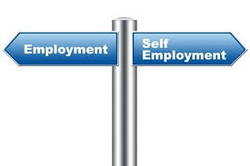Are you an employee or a self-employed independent contractor?

Whether a person is in a business relationship (self-employed independent contractor) or in an employee-employer relationship is not one that is always easy to answer. Courts generally look at the following criteria in making their decisions:
• More control is generally exercised by an employer over an employee than by a client over a self-employed person
• Chance of profit/risk of loss - self-employed persons usually have some degree of financial risk, and more opportunity for profit than employees
• Integration - an employee's job will be an integral part of an employer's business, where the tasks performed by a self-employed person will likely be less integrated with the client's business
• Tools and equipment - self-employed persons are more likely to be supplying their own tools and equipment, as well as being responsible for their maintenance
Employee advantages:
• Qualify for employment insurance
• Canada Pension Plan premiums paid 50% by employer
• Participation in employee benefits, including:
• Vacation pay
• Provincial medical plan
• Extended health benefits - medical, dental, vision care
• Disability insurance
• Pension plans
• Workers' compensation coverage
• Higher rate of pay for overtime hours
• More difficult to be terminated
• Severance pay if terminated
• No record keeping required
• Eligible for Canada employment amount tax credit
Employee disadvantages:
• Must pay employment insurance premiums - see EI premium rates
• Very few expenses are tax-deductible - see our article on deductible employment expenses
• Less control over working conditions and hours
Self-employed advantages:
• No employment insurance premiums, unless voluntarily paid
• More expenses are tax-deductible - for example, expense of travelling to and from clients' places of business is tax-deductible
• More freedom to choose own working hours
• Can work for more than one client
• In first year of operation, income tax not payable until April 30th following first year end opportunity for increased profits
• Can recover GST or HST paid by registering to collect GST/HST, even small suppliers
Self-employed disadvantages:
• No severance pay if terminated
• Cannot collect employment insurance, except special benefits
• Must pay employee and employer portions of Canada Pension Plan contribution - see CPP contribution rates
• More record-keeping required
• Often work longer hours with no extra pay
• Cost of purchasing and maintaining own equipment
• Risk of loss
• Liable if contract obligations not fulfilled, thus liability insurance may be needed
• No employee benefits, including disability insurance (make sure you get your own disability insurance policy!)
• After first year-end, usually must make income tax installment payments
• Must register to collect GST, except for small suppliers - see who has to collect GST on our GST page
• Must register to collect PST in most provinces - see our PST page.
• Cash management and planning required to ensure funds available for tax remittances
• May require services of bookkeeper or accountant for the record-keeping and government reporting
• Not eligible for Canada employment amount tax credit
Source: http://www.taxtips.ca
• More control is generally exercised by an employer over an employee than by a client over a self-employed person
• Chance of profit/risk of loss - self-employed persons usually have some degree of financial risk, and more opportunity for profit than employees
• Integration - an employee's job will be an integral part of an employer's business, where the tasks performed by a self-employed person will likely be less integrated with the client's business
• Tools and equipment - self-employed persons are more likely to be supplying their own tools and equipment, as well as being responsible for their maintenance
Employee advantages:
• Qualify for employment insurance
• Canada Pension Plan premiums paid 50% by employer
• Participation in employee benefits, including:
• Vacation pay
• Provincial medical plan
• Extended health benefits - medical, dental, vision care
• Disability insurance
• Pension plans
• Workers' compensation coverage
• Higher rate of pay for overtime hours
• More difficult to be terminated
• Severance pay if terminated
• No record keeping required
• Eligible for Canada employment amount tax credit
Employee disadvantages:
• Must pay employment insurance premiums - see EI premium rates
• Very few expenses are tax-deductible - see our article on deductible employment expenses
• Less control over working conditions and hours
Self-employed advantages:
• No employment insurance premiums, unless voluntarily paid
• More expenses are tax-deductible - for example, expense of travelling to and from clients' places of business is tax-deductible
• More freedom to choose own working hours
• Can work for more than one client
• In first year of operation, income tax not payable until April 30th following first year end opportunity for increased profits
• Can recover GST or HST paid by registering to collect GST/HST, even small suppliers
Self-employed disadvantages:
• No severance pay if terminated
• Cannot collect employment insurance, except special benefits
• Must pay employee and employer portions of Canada Pension Plan contribution - see CPP contribution rates
• More record-keeping required
• Often work longer hours with no extra pay
• Cost of purchasing and maintaining own equipment
• Risk of loss
• Liable if contract obligations not fulfilled, thus liability insurance may be needed
• No employee benefits, including disability insurance (make sure you get your own disability insurance policy!)
• After first year-end, usually must make income tax installment payments
• Must register to collect GST, except for small suppliers - see who has to collect GST on our GST page
• Must register to collect PST in most provinces - see our PST page.
• Cash management and planning required to ensure funds available for tax remittances
• May require services of bookkeeper or accountant for the record-keeping and government reporting
• Not eligible for Canada employment amount tax credit
Source: http://www.taxtips.ca

